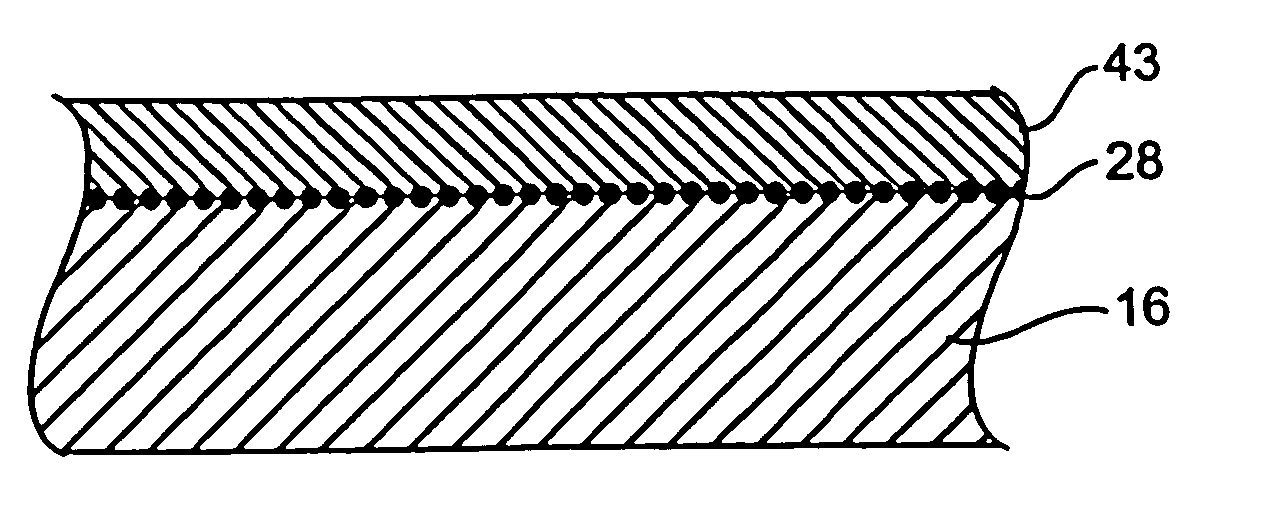Devices delivering therapeutic agents and methods regarding the same
a technology of therapeutic agents and devices, applied in the field of medical devices and methods, can solve the problems of no one of these procedures is proven to be completely successful in substantially or completely avoiding all occurrences of restenosis and hyperplasia, and continues to suffer significant disadvantages, etc., to achieve minimal to no hindrance, minimize drug washout, and improve efficiency and/or efficacy
- Summary
- Abstract
- Description
- Claims
- Application Information
AI Technical Summary
Benefits of technology
Problems solved by technology
Method used
Image
Examples
example 1
[0211] A stainless steel Duraflex™ stent (available from Avantec Vascular Corporation, having a place of operation in California), having dimensions of 3.0 mm×14 mm is sprayed with a solution of 25 mg / ml therapeutic capable agent in a 100% ethanol or methanol solvent. The stent is dried and the ethanol is evaporated leaving the therapeutic capable agent on the stent surface. A 75:25 PLLA / PCL copolymer (sold commercially by POLYSCIENCES) is prepared in 1,4 Dioxane (sold commercially by ALDRICH CHEMICALS). The therapeutic capable agent loaded stent is loaded on a mandrel rotating at 200 rpm and a spray gun (sold commercially by BINKS MANUFACTURING) dispenses the copolymer solution in a fine spray on to the therapeutic capable agent loaded stent as it rotates for a 10-30 second time period. The stent is then placed in an oven at 25-35° C. up to 24 hours to complete evaporation of the solvent.
example 2
[0212] A Stainless steel Duraflex stent (3.0×14 mm) was laser cut from a SS tube. The surface area of the stent for receiving the therapeutic capable agent was increased by increasing the surface roughness of the stent. The surface area and the volume of the stent can be further increased by creating 10 nm wide by 5 nm deep grooves along the links of the stent strut. The grooves were created in those stent areas experiencing low stress during expansion so as not to compromise the stent radial strength. The drug was loaded onto the stent and in the stent grooves by dipping or spraying the stent in the therapeutic capable agent solution prepared in low surface tension solvent such as isopropyl alcohol, ethanol, or methanol. The stent was then dried with the therapeutic capable agent remaining on the stent surface, and in the grooves which served as a reservoir for the therapeutic capable agent. Parylene was then vacuum deposited on the stent to serve as a rate-sustaining or rate-contr...
example 3
[0213] A therapeutic capable agent was dissolved in methanol, then sprayed onto the stent. The stent was left to dry with the solvent evaporating from the stent leaving the therapeutic capable agent on the stent. A rate-sustaining or rate-controlling element (e.g., silicone, polyurethane, polytetrafluorethylene, parylene, parylene C, non-porous parylene C, PARYLAST™, PARYLAST™ C) was sprayed or deposited on the stent covering the therapeutic capable agent. The amount of therapeutic capable agent varied from about 10 micrograms to 2 milligrams, with release rates from 1 day to 45 days.
PUM
 Login to View More
Login to View More Abstract
Description
Claims
Application Information
 Login to View More
Login to View More - R&D
- Intellectual Property
- Life Sciences
- Materials
- Tech Scout
- Unparalleled Data Quality
- Higher Quality Content
- 60% Fewer Hallucinations
Browse by: Latest US Patents, China's latest patents, Technical Efficacy Thesaurus, Application Domain, Technology Topic, Popular Technical Reports.
© 2025 PatSnap. All rights reserved.Legal|Privacy policy|Modern Slavery Act Transparency Statement|Sitemap|About US| Contact US: help@patsnap.com



